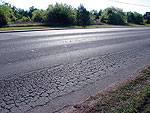 Got a road that’s ailing? Many older ones are. Perhaps the proper treatment requires a radical and expensive replacement of the entire roadway. But what if a less expensive procedure can cure what’s ailing that road…how’s a pavement engineer to know?
Got a road that’s ailing? Many older ones are. Perhaps the proper treatment requires a radical and expensive replacement of the entire roadway. But what if a less expensive procedure can cure what’s ailing that road…how’s a pavement engineer to know?
Using tools such as falling weight deflectometers (FWD) and ground penetrating radar (GPR), Tom Scullion, Texas Transportation Institute (TTI) senior research engineer and manager of TTI’s Pavement Systems Program, diagnoses road problems using non-destructive test data and custom software. Over the past decade, he has developed a set of unique investigation tools. Scullion and Andrew Wimsatt, head of TTI’s Materials and Pavements Division, now teach other pavement engineers and maintenance personnel how to analyze and cure road failures.
“One of the biggest challenges facing district design engineers and area office engineers is figuring out what to do with worn-out roads, and hopefully how to fix them without resorting to major surgery,” says Scullion. The workshop is designed to do just that.
The biggest obstacle in proper, cost-effective road rehabilitation is determining the root cause of the road failure. “Over the last 10 or 15 years, we’ve developed some very useful tools in the research arena. The tools we have include structural testing with FWDs and testing with GPR, dynamic cone penetrometers and other strength testing techniques,” notes Scullion. The workshop teaches designers how to integrate and use the data obtained from these devices to diagnose pavement problems.
Prior to conducting a course for the Texas Department of Transportation (TxDOT), Scullion contacts the host district and asks about problem pavements in the area. “We use these tools while we’re there or ahead of time to collect data. We go through all the basics in the class, what the tools do and how to use them. At the end of the workshop, we then show the students the data from their actual projects. The class is very hands-on and practical,” Scullion explains.
Scullion and Wimsatt teach three workshops each year for TxDOT personnel. In 2008, Austin, Beaumont and Laredo participated. One Laredo site investigated by Scullion was an IH-35 access road. The surface exhibited alligator cracking. Based on information collected and used in the class, the district was able to change its rehabilitation plans, and the citizens of Laredo benefited.
Jo Ann E. Garcia, transportation engineer in the TxDOT Laredo District and a student in the recent Laredo class, explains: “We went to a lesser depth repair. That reduced cost. We ended up adding more miles to that contract. We worked with the budget we initially had, and we’re taking care of more miles. Motorists get to drive on a better riding roadway and get to use it sooner.”
Scullion’s goal is to introduce new technologies to road maintenance personnel. “These tools we developed in research can really help them,” says Scullion. “It’s the best way to select the optimum repair strategy.”
When it comes to sick pavements, the “Road Doctors” have perfected the cure. Scullion observes, “It’s pretty straightforward designing new highways. We pretty much know what works and what doesn’t work. The real challenge is figuring out what to do with these old, worn-out roads.”
